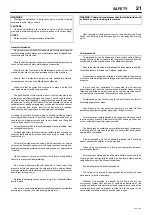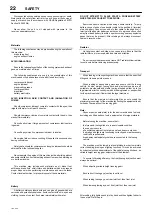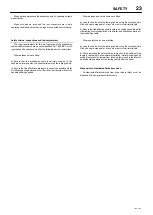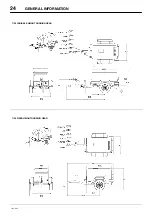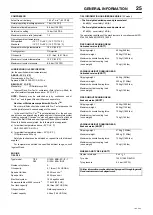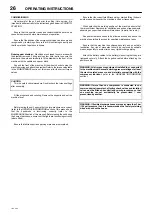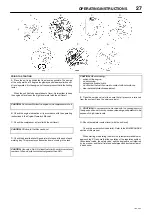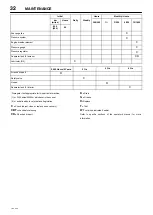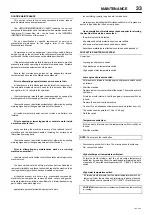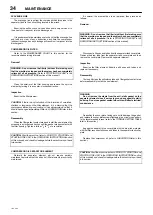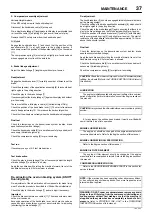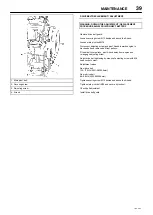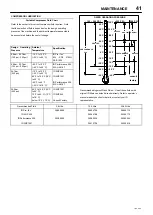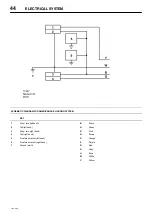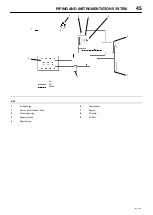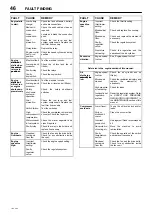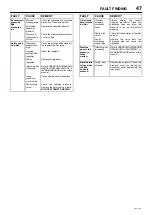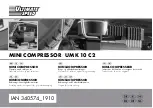
MAINTENANCE
35
7/20, P65
COMPRESSOR OIL COOLER AND ENGINE RADIATOR
When grease, oil and dirt accumulate on the exterior surfaces of the oil
cooler and radiator, the efficiency is impaired. It is recommended that
each month the oil cooler and radiator be cleaned by directing a jet of
compressed air, (carrying if possible a non
−
flammable cleaning
solvent) over the exterior core of the cooler/radiator. This should
remove any accumulation of oil, grease and dirt from the exterior core
of the cooler so that the entire cooling area can radiate the heat of the
lubricating and cooling oil/water into the air stream.
WARNING: Hot engine coolant and steam can cause injury. When
adding coolant or antifreeze solution to the engine radiator, stop
the engine at least one minute prior to releasing the radiator filler
cap. Using a cloth to protect the hand, slowly release the filler cap,
absorbing any released fluid with the cloth. Do not remove the
filler cap until all excess fluid is released and the engine cooling
system fully depressurised.
WARNING: Follow the instructions provided by the antifreeze
supplier when adding or draining the antifreeze solution. It is
advisable to wear personal protective equipment to prevent skin
and eye contact with the antifreeze solution.
AIR FILTER ELEMENTS
The air filter should be inspected regularly (refer to the
SERVICE/MAINTENANCE CHART
) and the element replaced when
the restriction indicator shows red or every 6 Months (500 hours),
whichever comes first. The dust collector box(es) should be cleaned
daily (more frequently in dusty operating conditions) and not allowed to
become more than half full.
Removal
CAUTION:
Never remove and replace element(s) when the machine
is running.
Clean the exterior of the filter housing and remove the filter element
by releasing the nut.
Inspection
Check for cracks, holes or any other damage to the element by
holding it up to a light source, or by passing a lamp inside.
Check the seal at the end of the element and replace if any sign of
damage is evident.
Reassembly
Assemble the new element into the filter housing ensuring that the
seal seats properly.
Reset the restriction indicator by depressing the rubber diaphragm.
Assemble the dust collector box parts, ensuring that they are
correctly positioned.
Before restarting the machine, check that all clamps are tight.
VENTILATION
Always check that the air inlets and outlets are clear of debris etc.
CAUTION:
NEVER clean by blowing air inwards.
COOLING FAN DRIVE
Periodically check that the fan mounting bolts in the fan hub have
not loosened. If, for any reason, it becomes necessary to remove the
fan or re
−
tighten the fan mounting bolts, apply a good grade of
commercially available thread locking compound to the bolt threads
and tighten to the torque value shown in the
TORQUE SETTING
TABLE
later in this section.
The fan belt(s) should be checked regularly for wear and correct
tensioning.
FUEL SYSTEM
The fuel tank should be filled daily or every eight hours. To minimise
condensation in the fuel tank(s), it is advisable to top up after the
machine is shut down or at the end of each working day. At six month
intervals drain any sediment or condensate that may have
accumulated in the tank(s).
FUEL FILTER WATER SEPARATOR
The fuel filter water separator contains a filter element which should
be replaced at regular intervals (see the
SERVICE/MAINTENANCE
CHART
).
HOSES
All components of the engine cooling air intake system should be
checked periodically to keep the engine at peak efficiency.
At the recommended intervals, (see the
SERVICE/MAINTENANCE CHART
), inspect all of the intake lines to
the air filter, and all flexible hoses used for air lines, oil lines and fuel
lines.
Periodically inspect all pipework for cracks, leaks, etc. and replace
immediately if damaged.
ELECTRICAL SYSTEM
WARNING: Always disconnect the battery cables before
performing any maintenance or service.
Inspect the safety shutdown system switches and the instrument
panel relay contacts for evidence of arcing and pitting. Clean where
necessary.
Check the mechanical action of the components.
Check the security of electrical terminals on the switches and relays
i.e. nuts or screws loose, which may cause local hot spot oxidation
.
Inspect the components and wiring for signs of overheating i.e.
discolouration, charring of cables, deformation of parts, acrid smells
and blistered paint.
BATTERY
Keep the battery terminals and cable clamps clean and lightly
coated with petroleum jelly to prevent corrosion.
The retaining clamp should be kept tight enough to prevent the
battery from moving.
PRESSURE SYSTEM
At 500 hour intervals it is necessary to inspect the external surfaces
of the system (from the airend through to the discharge valve(s))
including hoses, tubes, tube fittings and the separator tank, for visible
signs of impact damage, excessive corrosion, abrasion, tightness and
chafing. Any suspect parts should be replaced before the machine is
put back into service.

